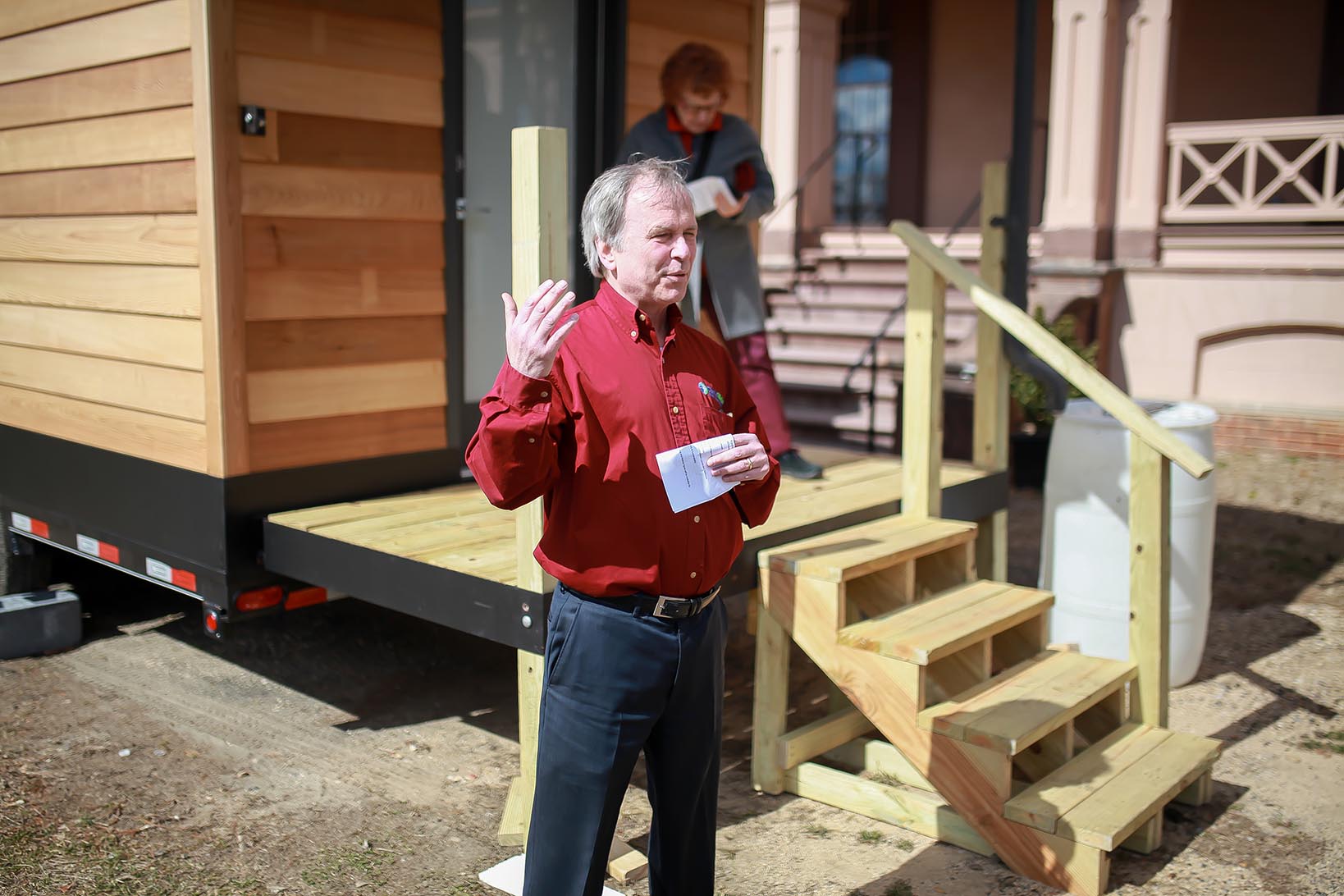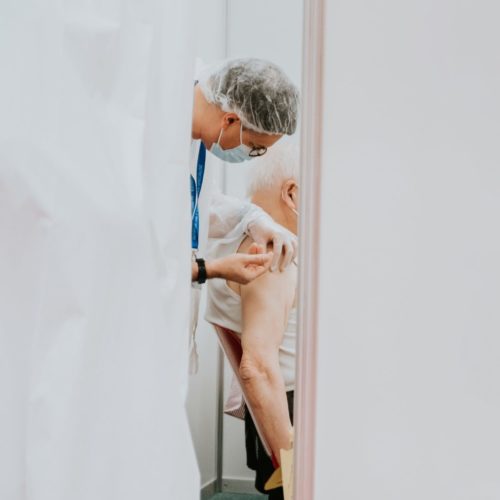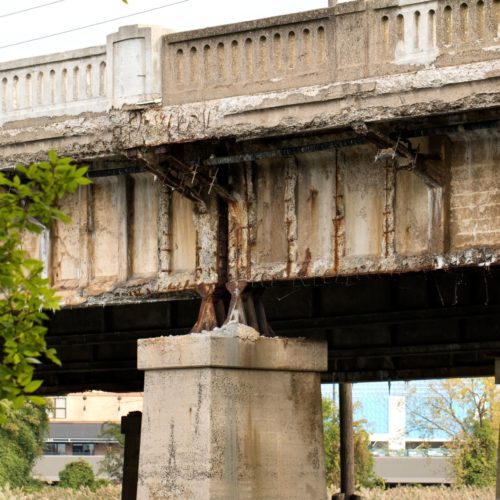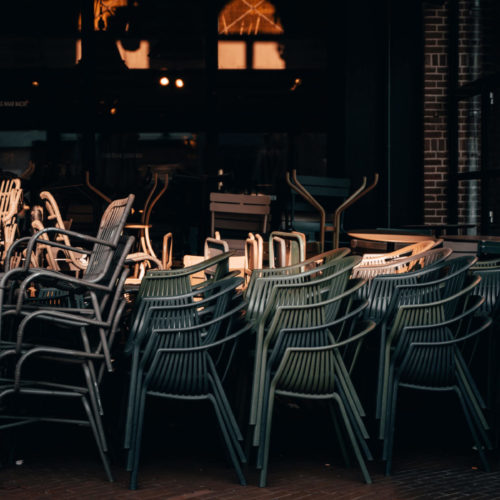In Baltimore, delivering food to the homebound during the pandemic
This post is part of an occasional series exploring how our members are addressing the effects of the coronavirus outbreak in their states.

Maryland Delegate Dana Stein outside a tiny house built by Civic Works. Credit: Civic Works
Soon after Maryland Governor Larry Hogan issued stay-at-home orders on March 30, the phones at Civic Works began to ring.
The Baltimore-based nonprofit, which provides a range of job-training and community service programs, was deluged with requests for food from low-income elderly people unable to travel to a grocery store.
Food delivery typically comprises a small portion of Civic Works’ mission in the community, but the organization was well positioned to help. Throughout much of the year, staff and volunteers grow fruit and vegetables at an urban farm located in a city park, and distribute meals to a small number of seniors. Some funders, aware of the rising food insecurity among local residents, offered grants so that Civic Works could ramp up its deliveries.
“Our food and farm manager said, ‘Yes, we can figure this out,’ ’’ said Maryland Delegate Dana Stein, the organization’s co-founder and executive director.
The COVID-19 pandemic has prompted a spike in demand for food assistance across the nation, and there have been reports of lines of cars stretching for miles outside food banks and at food distribution sites. In Baltimore City, officials have estimated that a third of residents will qualify for federal food assistance in the coming weeks as businesses close down and lay off workers.
At Civic Works, meeting the heightened need would require a reordering of staff. The organization trains people for jobs in sustainability and health care, educates teens at a community high school, and offers job placement for at-risk youths. With most of those projects halted or moving online, many employees were willing to pitch in to assemble and distribute meals.
“This is something they felt good about doing: [making] the direct connection to helping to feed people,” said Stein.
An exponential increase
As the requests for food deliveries accelerated, staff created a dedicated phone line to field the influx of calls. They found a local caterer willing to supply prepared meals at a discounted rate and pack them in individual containers. When callers place an order, they can choose from vegetarian or meat-based meals, and have the option to add other essentials, such as toilet paper and hand sanitizer, and fresh produce that is sourced from area growers and Civic Works’ urban farm.
The orders are assembled by a staff of around eight people, mostly members of AmeriCorps, the federally funded service program that provides grants to nonprofits such as Civic Works. Another staffer organizes the shipments by neighborhood, and distributes them to volunteer drivers.
“I’ll fill up the back seat of my car, and then for an hour or two I’ll drop meals off on people’s doorsteps,” said Stein, who has been delivering food to homes and apartments twice a week.
The organization typically provides meals to 50 households weekly; last week, it delivered 1,200. With some $100,000 in new grants, staff expect to be able to serve 1,000 meals every week through June.
The experience at Civic Works offers a hopeful example of resilience for other communities where food insecurity is on the rise. Many food distribution facilities have reported a shortage of volunteers who are staying home amid sheltering-in-place orders or out of fear of becoming infected, further limiting food access. Stein said that Civic Works assured its staff that it was observing strict safety measures to minimize any risk of infection. Employees were issued N95 masks and protective gloves, and they routinely disinfect food-distribution surfaces.
“I think once we made clear that we’re following all of the hygiene and distancing guidelines, people were okay to come,” he said.
Bridging the distribution gap
The growing food insecurity in Baltimore and communities nationwide contrasts with accounts of farms amassing huge quantities of food that they cannot sell. There have been reports of dairy farmers dumping thousands of gallons of milk, and vegetable growers plowing under fields of crops because distribution networks have broken down. Many of these producers sell to large commercial customers, such as restaurants and schools, that stopped buying after they were forced to shut their doors during the pandemic. Farmers say that redistributing their products to smaller retail outlets would be prohibitively costly and logistically challenging.
So far, Civic Works has been able to source enough food from farms in and around Baltimore for its meal deliveries, but there is concern that supplies may dwindle if the current lockdown orders continue into the summer. “If this goes on for three months, I don’t know if we’re going to be able to get all the food we need to seniors we’re delivering to,” said Stein.
Stein, who is vice-chair of the Environment and Transportation Committee in the Maryland House of Delegates, said the disconnect has laid bare the need for a reliable transportation and distribution network that can quickly adapt during a crisis. Finding a way to bridge the distribution gap and help farmers get their products to those who need them the most should be an essential component of emergency planning going forward, he said.
During his time in the state legislature, Stein has been a staunch supporter of efforts to address climate change, and to avoid the massive global disruptions that could flow from extreme weather, food shortages, global conflict, and pandemics.
Many advocates of climate action have noted that the current collaborative efforts among states in the Northeast to slow the spread of COVID-19 show that when communities and leaders join forces to address a shared threat, rapid change is possible.
The COVID-19 health and economic crisis “just reinforces the sense that in the future, climate shocks to the system are going to create a similar type of emergency that we need to be prepared for,” said Stein.





